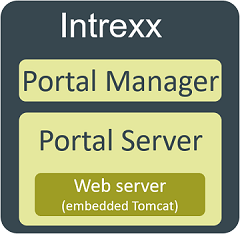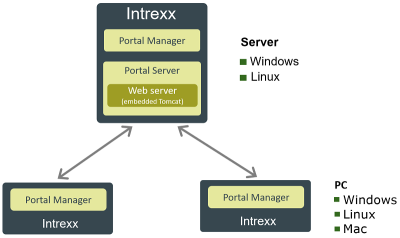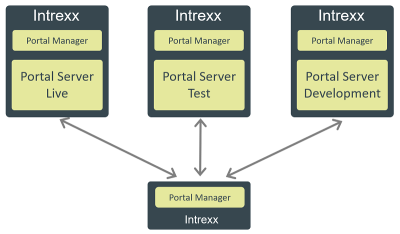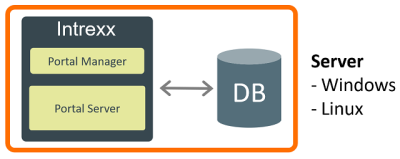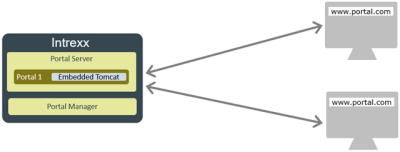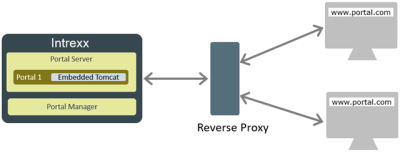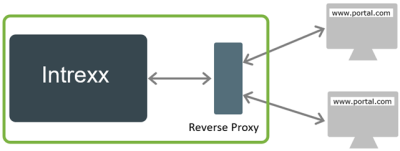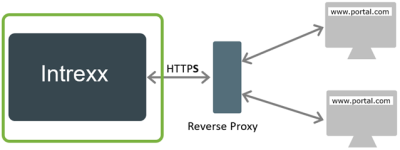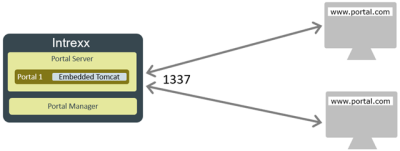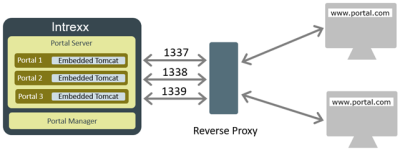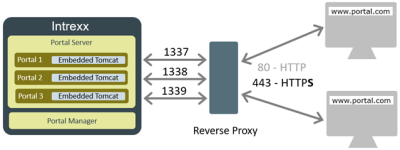Intrexx architecture
Before installing Intrexx, it is helpful to understand some of the key concepts of the Intrexx architecture.
Portal Server, Portal Manager, embedded Tomcat (web server)
Intrexx consists of the following two central components: Portal Server and Portal Manager
Portal Server Your portals run on the Portal Server. The server does not have a graphical user interface. In a Windows environment, each portal on the Portal Server has its own service. The name of the service is "Intrexx Portal [my portal]". You will be asked to restart this service during the upgrade.
Portal Manager The Portal Manager is the part of Intrexx where you create and administrate portals.
Web server (embedded Tomcat) From Version 19.03 onwards, Intrexx contains an embedded web server as an integral component. This is the Apache Tomcat.
So when you upgrade from Intrexx 18.03 (or a previous version) to Intrexx Silent Track, the embedded Tomcat is automatically installed as well. This can cause fundamental changes to your previous Intrexx configuration because you no longer require an own web server to run your portal.
More detailed information about Apache Tomcat is available here: https://tomcat.apache.org
Distributed installation
The Portal Manager and Portal Server (including the embedded Tomcat) are normally installed on a physical or virtual server to begin with. Additional Portal Manager instances are typically installed on other computers.
Method of operation with a distributed installation
The everyday work with Intrexx is performed using the Portal Manager that is installed on a PC.
This includes, for example, the development of applications, the creation and configuration of processes and the design of layouts.
Certain tasks must be performed with the Portal Manager installed on the server.
Jobs are performed on the Portal Server that occur more irregularly such as performing error analyses or upgrades.
Granular permissions can be granted with a distributed installation. In this way, the user of the Portal Manager, which is installed on a PC, does not need special permissions for the server.
Access multiple Portal Servers
You can connect to different Portal Servers via the same Portal Manager (installed on a PC). You can change to a different Portal Server once the Portal Manager has started.
Portals
You can run multiple portals with Intrexx or rather on the Intrexx Portal Server.
These can be multiple live portals or separate development and test portals. When a new portal is created, a new embedded Tomcat is implemented in each case.
Live portals and test and development portals should be implemented on separate Intrexx Portal Servers. In this way, you can test updates or upgrades on the test or development portal first before installing them on your live portal.
Portal and database
When you create a new portal with Intrexx, Intrexx will ask you to choose a database server and to create a new database there or use an existing (empty) database.
You need to install the database server or database type you would like before installing Intrexx. The database server can be on the same (physical or virtual) server as Intrexx.
However, Intrexx and the database server can also be installed on different (physical or virtual) servers.
Using a reverse proxy
Normally, a reverse proxy is used together with Intrexx. This is typically IIS from Microsoft or NGINX.
Neither product is a component of Intrexx, meaning they are not provided with Intrexx.
Using a reverse proxy is recommended for numerous reasons. In particular, a reverse proxy allows an existing Windows authentication to be used to access the portal.
Note The installation and configuration of the reverse proxy represents a significant part of the installation or upgrade from Intrexx 18.03 to Intrexx Silent Track.
There are some key differences to previous versions of Intrexx with regard to using websites instead of virtual directories. This is reflected in the correspondingly modified edit fields that need to be maintained in the portal properties.
This online guide provides key information relating to IIS for the installation or upgrade of Intrexx.
Equally, it may prove useful to familiarize yourself with the functions of IIS in more detail. The same applies to NGINX.
In principle, a portal can be accessed without a reverse proxy, however, this is only recommended for test and development portals.
You should use a reverse proxy for live portals.
Intrexx and the reverse proxy on one server
Intrexx and the reverse proxy can be installed on one (physical or virtual) server. In this case, an encrypted connection between the Intrexx Server and the proxy server is not required because they communicate locally on the same physical server. An encrypted connection (SSL/HTTPS) is required between the reverse proxy and the browser. The encryption is configured in and performed by the reverse proxy.
Intrexx and the reverse proxy on different servers
Intrexx and the reverse proxy can be installed on different (physical or virtual) servers. In this case, it is recommended that both the connection between the reverse proxy and the browser and the connection between Intrexx and the reverse proxy are encrypted because communications are already being made across a network.
Ports
Embedded Tomcat By default, the embedded Tomcat listens to the port 1337. This port is used by Intrexx for a new installation. Intrexx increases the port number by one for every additional portal. When upgrading, you can leave the port from the previous version as it is.
Please note: The port 1337 is preconfigured for a new installation of Intrexx 21.03. When upgrading, Intrexx adopts the port that you used in the earlier Intrexx version. You can leave this port as it is. Reverse proxy By default, the reverse proxy (IIS) listens to port 80 when you configure an HTTP connection. It listens to port 443 when you configure an HTTPS connection. An HTTPS connection is mandatory from Intrexx 19.03 onwards.
Please note that the ports may need to be opened in your firewall. This is especially important and necessary if you change the ports when upgrading.
